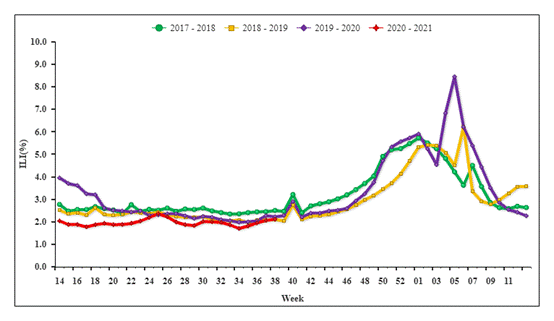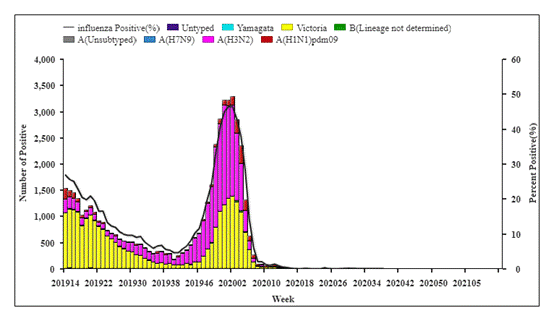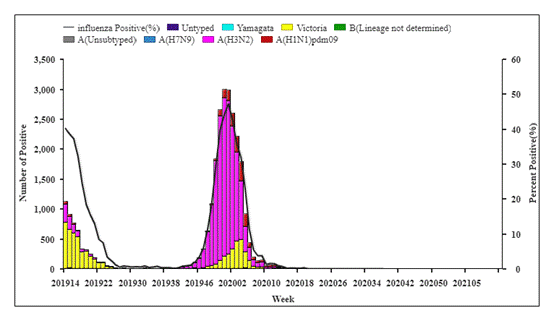Weekly Report
Week 38 2020
Article source:病毒病所 Date time:2020-09-29
Download:China flu report 2038.pdf
Chinese Influenza Weekly Report
(All data are preliminary and may change as more reports are received)
|
Summary l During week 38, the influenza activity in mainland China was still at a very low level, there was almost no positive specimen detected. l Among influenza viruses antigenically characterized by CNIC since October 1st, 2019, 809(96.2%) influenza A(H1N1)pdm09 viruses were characterized as A/Brisbane/02/2018-like; 47(3.8%) influenza A(H3N2) viruses were characterized as A/Kansas/14/2017 (EGG)-like, 101(8.3%) influenza A(H3N2) viruses were characterized as A/Kansas/14/2017 (CELL)-like; 183(16.9%) influenza B/Victoria viruses were characterized as B/Colorado/06/2017-like; 2(100%) influenza B/Yamagata viruses were characterized as B/Phuket/3073/2013-like. l Among the influenza viruses tested by CNIC for antiviral resistance analysis since October 1st, 2019, all influenza A(H1N1)pdm09 and A(H3N2) viruses were resistant to adamantine; All influenza A(H3N2) and B viruses were sensitive to neuraminidase inhibitors. All but 1 influenza A(H1N1)pdm09 were sensitive to neuraminidase inhibitors. |
Surveillance of outpatient or emergency visits for Influenza-like Illness (ILI)
During week 38 (Sep 14th –20th 2020) , the percentage of outpatient or emergency visits for ILI (ILI%) at national sentinel hospitals in southern provinces was 3.9%, higher than the last week (3.5%), higher than the same week of 2017-2019 (3.1%, 2.9% and 3.2%). (Figure 1)

Figure 1. Percentage of Visits for ILI at Sentinel Hospitals in South China
(2017-2021)
Note: Since the outbreak of COVID-19, patients with fever are required to go to the fever clinics in separate areas of hospitals for treatment, which may enhance the sensitivity of surveillance. And some network hospitals admitted more ILI cases than before, with ILI% increased accordingly. The data cannot be compared with the same period in previous years.
During week 38, ILI% at national sentinel hospitals in northern provinces was 2.1%, same as the last week (2.1%), lower than the same week of 2017 and 2019 (2.5%, 2.1%), equal to the same week of 2018 (2.1%). (Figure 2)

Figure 2. Percentage of Visits for ILI at Sentinel Hospitals in North China
(2017-2021)
Virologic Surveillance
During week 38, influenza network laboratories tested 6089 specimens, there was two positive detection for influenza. The number and proportion of influenza types and subtypes detected in southern and northern provinces are shown in Table 1.
Table 1 Laboratory Detections of ILI Specimens (Week 38, 2020)
|
|
Week 38 |
||
|
South China |
North China |
Total |
|
|
No. of specimens tested |
4709 |
1380 |
6089 |
|
No. of positive specimens (%) |
2(0%) |
0 |
2(0%) |
|
Influenza A |
0 |
0 |
0 |
|
A(H3N2) |
0 |
0 |
0 |
|
A(H1N1)pdm09 |
0 |
0 |
0 |
|
A (subtype not determined) |
0 |
0 |
0 |
|
Influenza B |
2(100%) |
0 |
2(100%) |
|
B (lineage not determined) |
0 |
0 |
0 |
|
Victoria |
2(100%) |
0 |
2(100%) |
|
Yamagata |
0 |
0 |
0 |

Figure 3. Influenza Positive Tests Reported by Southern Network Laboratories (Week 14, 2019–Week 13, 2021)
Note: Analysis in this part was based on the test results of network laboratories. If it were not consistent with the results of CNIC confirmation, the results of CNIC confirmation were used.

Figure 4. Influenza Positive Tests Reported by Northern Network Laboratories (Week 14, 2019–Week 13, 2021)
Note: Analysis in this part was based on the result of network laboratories. If it were not consistent with the results of CNIC confirmation, the results of CNIC confirmation were used.
Antigenic Characterization
Since October 1st, 2019, 809(96.2%) influenza A(H1N1)pdm09 viruses were characterized as A/Brisbane/02/2018-like; 47(3.8%) influenza A(H3N2) viruses were characterized as A/Kansas/14/2017 (EGG)-like, 101(8.3%) influenza A(H3N2) viruses were characterized as A/Kansas/14/2017 (CELL)-like; 183(16.9%) influenza B/Victoria viruses were characterized as B/Colorado/06/2017-like; 2(100%) influenza B/Yamagata viruses were characterized as B/Phuket/3073/2013-like.
Antiviral Resistance
Since October 1st, 2019, among the influenza viruses tested by CNIC for antiviral resistance, all influenza A(H1N1)pdm09 and A(H3N2) viruses were resistant to adamantine; All influenza A(H3N2) and B viruses were sensitive to neuraminidase inhibitors. All but 1 influenza A(H1N1)pdm09 were sensitive to neuraminidase inhibitors.
Outbreak Surveillance
During week 38(Sep 14th –20th 2020), there were two ILI outbreaks reported nationwide, one of them was other pathogen, one of them was negative for Flu.
H7N9 Case Report
During week 38, no new human infection with novel reassortant influenza A(H7N9) virus was reported.

